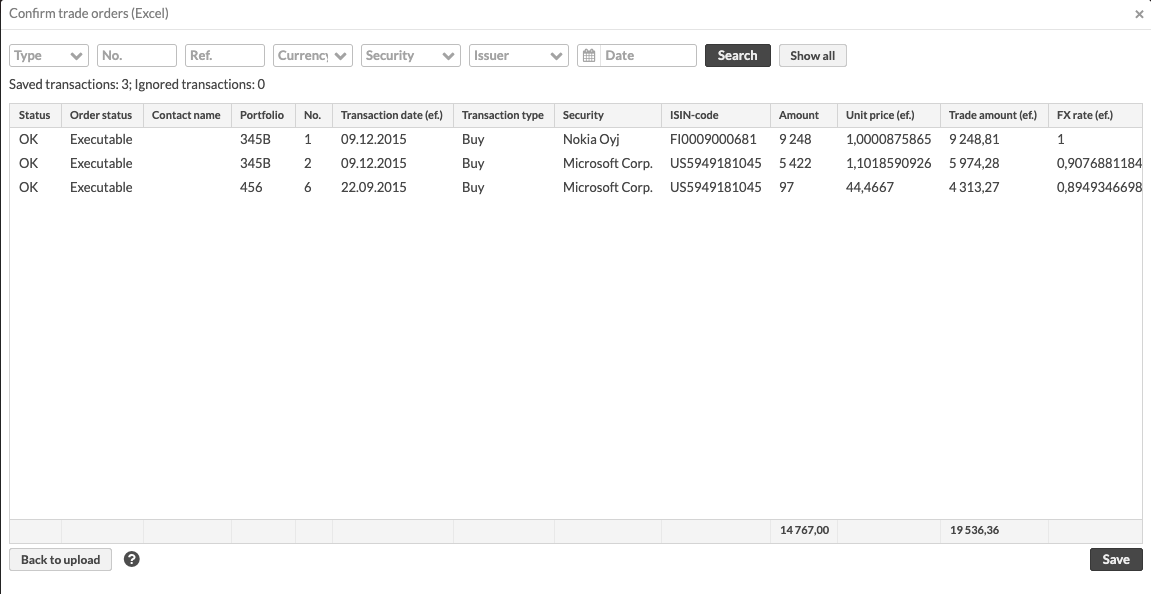Confirm trade orders (Excel)
Confirm trade orders (Excel) on the Trade orders view you allows you to execute trade orders created in the system that have been confirmed in the market with an XLSX file.
Steps to execute trade orders with an Excel file
To execute trade orders by importing them as an XLSX file:
Export your open trade orders from the Trade orders view. Search for the trade orders you want to send forward, and click the XLS icon at the top-right of the view to export your search result as an XLSX file. Make sure you have selected all necessary information as visible columns on the view so that they will be included in you export.
Change the status of the trade orders you sent forward to be Executable. Changing the status of a trade order from open to executable locks the trade order and prevents making further changes to it before it is executed, guaranteeing you will have the same trade orders you sent forward untouched in the system.
Once the orders are confirmed in the market, modify the XLSX file you originally exported from the system with the effective information (amount, date, unit price, exchange rate, and so on). Note that the date should be in the YYYY-MM-DD format.
Import the same file back to the system through Confirm trade orders (Excel) to execute the trade orders.
Pre-requisites for executing trade orders with Excel
Before exporting your trade orders as an XLSX file, make sure you have at least the following required columns included:
Order status
Portfolio
Security
Transaction No
Dates, amount, unit price (ef.), trade amount (ef.)
Currency and FX rate
In addition to the required columns, you can have any number of columns you want to be able to send out to the market or define to your transactions when you execute your orders. For example, if you want to add costs during the execution, select the appropriate "cost" and "cost type" columns to be visible in your export file.
When importing the exported XLSX file back into the system with the Confirm trade orders (Excel), the XLSX file you are importing back to the system has to contain the same columns you currently have visible on the Trade orders view - if the columns and their order in the file you are importing back to the system don't match to the columns currently visible on the Trade orders view, the system doesn't recognize the trade orders you are executing.
Confirm trade orders (Excel) works against different searches with different columns you have saved on the Trade orders view - just make sure you have the right saved search tab open when starting to confirm the trade orders and the columns in the opened tab match to the columns in your XLSX file.
Confirm trade orders (Excel) window
Confirm trade orders (Excel) on the Trade orders view you allows you to execute trade orders created in the system that have been confirmed in the market with an XLSX file.

Once you have started the execution, the first step is to upload the XLSX file you want to use to execute the trade orders. Make sure you are on the correct tab - the XLSX file you upload should contain the same columns you currently have visible on the Trade orders view.
Trade orders found in the uploaded XLSX file are listed in the second step. The Status column indicates whether a trade order in your file can be found as "open" or "executable" in the system, and can thus be executed. Saved / Ignored transactions at the top indicates the number of trade orders in your imported file that would be executed / ignored when you accept and save the execution.
You can either click Back to upload to re-upload the file or click Save to execute the trade orders. This creates transactions based on the information in your file and in the system (the columns missing from the file are copied from trade orders). The status of your trade orders changes to Executed. Only the trade orders visible will be executed - if you want to execute all trade orders within your file, clear all search criteria before saving, and if you want to execute only some of the trade orders, utilize the search criteria to restrict the trade orders to be executed.
Transactions created for executed trade orders
Transactions are created based on the information in the Excel file and in the system. You have modified the Excel file you originally exported from the system with the realized information (amount, date, unit price, exchange rate, etc.), and that information is used to create the transactions. If some information is present in the system but missing from the file (for example, internal info, tags, marketplace), it is also copied to the transactions.
Account of the transaction is set to be:
The account set to the trade order. If an account is set to the trade order, this account is used for the transaction as well.
If there is "No account" set for the trade order, then when executing the trade order, AUTO logic is applied:
The account in the portfolio with the same currency as the trade order is set as the account of the trade order.
If an account with the same currency as the trade order cannot be found from the portfolio, then the portfolio's default account is set as the account of the trade order.
If no accounts can be found from the portfolio, then the shared accounts available for the portfolio are used in the same order: by default setting the shared account with the same currency as the trade order, and if not found, then setting the shared default account.